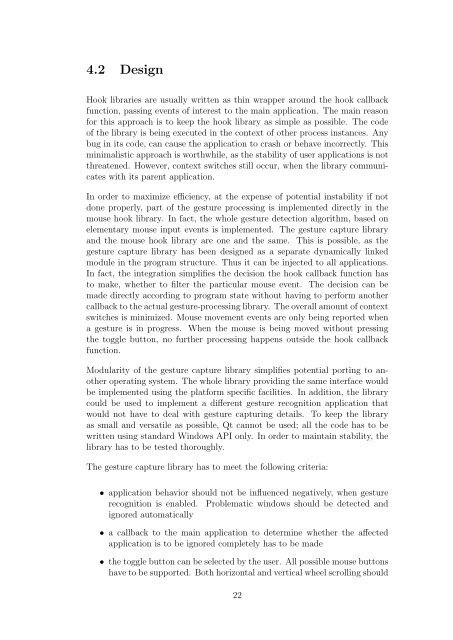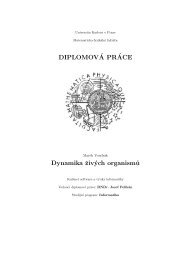Bachelor Thesis - Computer Graphics Group
Bachelor Thesis - Computer Graphics Group
Bachelor Thesis - Computer Graphics Group
You also want an ePaper? Increase the reach of your titles
YUMPU automatically turns print PDFs into web optimized ePapers that Google loves.
4.2 Design<br />
Hook libraries are usually written as thin wrapper around the hook callback<br />
function, passing events of interest to the main application. The main reason<br />
for this approach is to keep the hook library as simple as possible. The code<br />
of the library is being executed in the context of other process instances. Any<br />
bug in its code, can cause the application to crash or behave incorrectly. This<br />
minimalistic approach is worthwhile, as the stability of user applications is not<br />
threatened. However, context switches still occur, when the library communicates<br />
with its parent application.<br />
In order to maximize efficiency, at the expense of potential instability if not<br />
done properly, part of the gesture processing is implemented directly in the<br />
mouse hook library. In fact, the whole gesture detection algorithm, based on<br />
elementary mouse input events is implemented. The gesture capture library<br />
and the mouse hook library are one and the same. This is possible, as the<br />
gesture capture library has been designed as a separate dynamically linked<br />
module in the program structure. Thus it can be injected to all applications.<br />
In fact, the integration simplifies the decision the hook callback function has<br />
to make, whether to filter the particular mouse event. The decision can be<br />
made directly according to program state without having to perform another<br />
callback to the actual gesture-processing library. The overall amount of context<br />
switches is minimized. Mouse movement events are only being reported when<br />
a gesture is in progress. When the mouse is being moved without pressing<br />
the toggle button, no further processing happens outside the hook callback<br />
function.<br />
Modularity of the gesture capture library simplifies potential porting to another<br />
operating system. The whole library providing the same interface would<br />
be implemented using the platform specific facilities. In addition, the library<br />
could be used to implement a different gesture recognition application that<br />
would not have to deal with gesture capturing details. To keep the library<br />
as small and versatile as possible, Qt cannot be used; all the code has to be<br />
written using standard Windows API only. In order to maintain stability, the<br />
library has to be tested thoroughly.<br />
The gesture capture library has to meet the following criteria:<br />
• application behavior should not be influenced negatively, when gesture<br />
recognition is enabled. Problematic windows should be detected and<br />
ignored automatically<br />
• a callback to the main application to determine whether the affected<br />
application is to be ignored completely has to be made<br />
• the toggle button can be selected by the user. All possible mouse buttons<br />
have to be supported. Both horizontal and vertical wheel scrolling should<br />
22
















